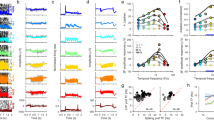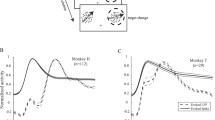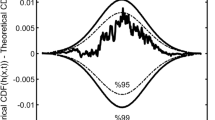Abstract
We constructed average histograms from responses evoked by flashing stimuli and noted previously described variations in the shape of the response profile, particularly with respect to sharpness of the peak. To express this variable, we measured the half-rise latency, which is the latency from stimulus onset required to reach half the maximum response. A short half-rise latency, which is characteristic of nonlagged cells, is associated with a brisk response and sharp peak; a long half-rise latency, characteristic of lagged cells, is associated with a sluggish response and broad peak. Nonlagged cells were readily seen; we attempted to identify cells with long latencies as lagged, but we were unable to do so unambiguously due to failure to observe lagged properties other than latency. We thus refer to these latter cells as having “lagged-like” responses to indicate that we are not certain whether these are indeed lagged cells. In addition to the histograms, we analyzed the individual response trials that were summed to create each histogram, and we used spike density analysis to estimate the initial response latency to the flashing spot for each trial. We found that lagged-like responses were associated with more variability in initial response latency than were nonlagged responses. We then employed an alignment procedure to eliminate latency variation from individual trials; that is, responses during individual trials were shifted in time as needed so that each had a latency equal to the average latency of all trials. We used these “aligned” trials to create a second, “aligned” response histogram for each cell. The alignment procedure had little effect on nonlagged responses, because these were already well aligned due to consistent response latencies amongst trials. For lagged-like responses, however, the alignment made a dramatic difference. The aligned histograms looked very much like those for nonlagged responses: the responses appeared brisk, with a sharply rising peak that was fairly high in amplitude. We thus conclude that the slow build up to a relatively low peak of firing of the lagged-like response histogram is not an accurate reflection of responses on single trials. Instead, the sluggishness of lagged-like responses inferred from average response histograms results from temporal smearing due to latency variability amongst trials. We thus conclude that there is relatively little difference in briskness between nonlagged and lagged-like responses to single stimuli.
Similar content being viewed by others
References
Bloomfield SA, Sherman SM (1988) Postsynaptic potentials recorded in neurons of the cat's lateral geniculate nucleus following electrical stimulation of the optic chiasm. J Neurophysiol 60:1924–1945
Bloomfield SA, Hamos JE, Sherman SM (1987) Passive cable properties and morphological correlates of neurones in the lateral geniculate nucleus of the cat. J Physiol (Lond) 383:653–692
Cleland BG, Levick WR (1974) Brisk and sluggish concentrically organized ganglion cells in the cat's retina. J Physiol (Lond) 240:421–456
Funke K, Eysel UT (1992) EEG-dependent modulation of response dynamics of cat dLGN relay cells and the contribution of corticogeniculate feedback. Brain Res 573:217–227
Hartveit E, Heggelund P (1990) Neurotransmitter receptors mediating excitatory input to cells in the cat lateral geniculate nucleus. II. Nonlagged cells. J Neurophysiol 63:1361–1372
Hartveit E, Heggelund P (1993) Brain-stem influence on visual response of lagged and nonlagged cells in the cat lateral geniculate nucleus. Vis Neurosci 10:325–339
Heggelund P, Hartveit E (1990) Neurotransmitter receptors mediating excitatory input to cells in the cat lateral geniculate nucleus. I. Lagged cells. J Neurophysiol 63:1347–1360
Hille B (1992) Ionic channels of excitable membranes. Sinauer Associates, Sunderland, MA, USA
Humphrey AL, Saul AB (1992) Action of brain stem reticular afferents on lagged and nonlagged cells in the cat lateral geniculate nucleus. J Neurophysiol 68:673–691
Humphrey AL, Weller RE (1988a) Functionally distinct groups of X-cells in the lateral geniculate nucleus of the cat. J Comp Neurol 268:429–447
Humphrey AL, Weller RE (1988b) Structural correlates of functionally distinct X-cells in the lateral geniculate nucleus of the cat. J Comp Neurol 268:448–468
Ikeda H, Wright MJ (1974) Sensitivity of neurones in the visual cortex (area 17) under different levels of anesthesia. Exp Brain Res 20:471–484
Kwon YH, Esguerra M, Sur M (1991) NMDA and non-NMDA receptors mediate visual responses of neurons in the cat's lateral geniculate nucleus. J Neurophysiol 66:414–428
Lo F-S, Lu S-M, Sherman SM (1991) Intracellular and extracellular in vivo recording of different response modes for relay cells of the cat's lateral geniculate nucleus. Exp Brain Res 83:317–328
Lu S-M, Guido W, Sherman SM (1992) Effects of membrane voltage on receptive field properties of lateral geniculate neurons in the cat: contributions of the low threshold Ca2+ conductance. J Neurophysiol 68:2185–2198
MacPherson JM, Aldridge JW (1979) A quantitative method of computer analysis of spike train data collected from behaving animals. Brain Res 175:183–187
Mastronarde DN (1987a) Two classes of single-input X-cells in cat lateral geniculate nucleus. II. Retinal inputs and the generation of receptive-field properties. J Neurophysiol 57:381–413
Mastronarde DN (1987b) Two classes of single-input X-cells in cat lateral geniculate nucleus. I. Receptive field properties and classification of cells. J Neurophysiol 57:357–380
Mastronarde DN, Humphrey AL, Saul AB (1991) Lagged Y cells in the cat lateral geniculate nucleus. Vis Neurosci 7:191–200
McClurkin JW, Gawne TJ, Optican LM, Richmond BJ (1991a) Lateral geniculate neurons in behaving primates. II. Encoding of visual information in the temporal shape of the response. J Neurophysiol 66:794–808
McClurkin JW, Gawne TJ, Richmond BJ, Optican LM, Robinson DL (1991b) Lateral geniculate neurons in behaving primates I. Responses to two-dimensional stimuli. J Neurophysiol 66:777–793
McCormick DA (1991) Functional properties of a slowly inactivating potassium current in guinea pig dorsal lateral geniculate relay neurons. J Neurophysiol 66:1176–1189
Optican LM, Richmond BJ (1987) Temporal encoding of two-dimensional patterns by single units in primate inferior temporal cortex. III. Information theoretic analysis. J Neurophysiol 57:162–178
Richmond BJ, Optican LM (1987) Temporal encoding of two-dimensional patterns by single units in primate inferior temporal cortex. II. Quantification of response waveform. J Neurophysiol 57:147–161
Richmond BJ, Optican LM (1990) Temporal encoding of two-dimensional patterns by single units in primate primary visual cortex. II. Information transmission. J Neurophysiol 64:370–380
Richmond BJ, Optican LM, Podell M, Spitzer H (1987) Temporal encoding of two-dimensional patterns by single units in primate inferior temporal cortex. I. Response characteristics. J Neurophysiol 57:132–146
Richmond BJ, Optican LM, Spitzer H (1990) Temporal encoding of two-dimensional patterns by single units in primate primary visual cortex. I. Stimulus-response relations. J Neurophysiol 64:351–369
Rogawski MA (1985) The A-current: how ubiquitous a feature of excitable cells is it? Trends Neurosci 8:214–219
Sanderson AC, Kobler B (1976) Sequential interval histogram analysis of nonstationary neuronal spike trains. Biol Cybern 22:61–71
Saul AB, Humphrey AL (1990) Spatial and temporal response properties of lagged and nonlagged cells in cat lateral geniculate nucleus. J Neurophysiol 64:206–224
Saul AB, Humphrey AL (1992a) Evidence of input from lagged cells in the lateral geniculate nucleus to simple cells in cortical area 17 of the cat. J Neurophysiol 68:1190–1208
Saul AB, Humphrey AL (1992b) Temporal-frequency tuning of direction selectivity in cat visual cortex. Vis Neurosci 8:365–372
Storm JF (1988) Temporal integration by a slowly inactivating K current in hippocampal neurons. Nature 336:379–381
Uhlrich DJ, Tamamaki N, Sherman SM (1990) Brainstem control of response modes in neurons of the cat's lateral geniculate nucleus. Proc Natl Acad Sci USA 87:2560–2563
Author information
Authors and Affiliations
Rights and permissions
About this article
Cite this article
Lu, S.M., Guido, W., Vaughan, J.W. et al. Latency variability of responses to visual stimuli in cells of the cat's lateral geniculate nucleus. Exp Brain Res 105, 7–17 (1995). https://doi.org/10.1007/BF00242177
Received:
Accepted:
Issue Date:
DOI: https://doi.org/10.1007/BF00242177




